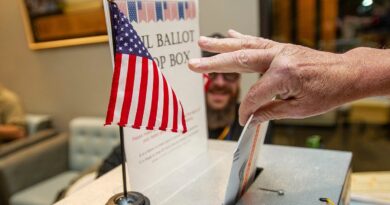Analysis | The inevitable end to claims of rampant voter fraud: None is found

This wasn’t enough to shift the results in Maricopa, where Joe Biden won by 45,000 votes. It was, however, an important part of the narrative: Here was a place where suspect ballots were cast, amplifying questions about the level of confidence one could have in the election results. The report recommended that “the Attorney General further investigate this finding to confirm the validity of this finding.”
Arizona’s attorney general did investigate the finding — and found that the finding had no validity. Of those 282 dead voters, only one was dead. Many of those contacted by his office, Attorney General Mark Brnovich (R) said in a letter, “were very surprised to learn they were allegedly deceased.”
The probe was yet another massive waste of state employees’ time and taxpayers’ money. There’s some slight benefit to the state in establishing that the allegation made by the auditing firm, Cyber Ninjas, had no merit. But Brnovich’s probe will not diminish skepticism about election results. Those who believed that the firm had uncovered dead voters solely on the basis of the presented evidence — which, despite all of those complicated numbers, was just a rough match of two lists of identities — will simply shift their assumptions about rampant fraud to one of the Ninjas’ other claims. That’s why the “audit” existed in the first place: to surround the election tally with as much just-asking-questions fog as possible.
It’s very easy to simply wave this away, to shrug at another claim of fraud falling apart. Why even bother covering it?
The answer is simple. As often as possible, we should highlight the fact that despite all of this attention and focus, no more than a dozen or two cases of fraud have come to light. The past 21 months have seen a flurry of allegations of varying complexity, asserting that statistical or circumstantial evidence shows that rampant fraud occurred. And every single time, those assertions crumple under scrutiny. This is not only the perpetual endgame for the claims, it’s the predictable one — as we keep seeing.
Consider the assertion that has been at the center of the fraud universe over the past several months, the idea that thousands of people worked to insert ballots in a smattering of drop boxes in a number of cities. Expressed succinctly, it’s not really clear what’s being alleged by that statement: Where did the ballots come from? Why not just drop them all in one drop box? Is that even illegal? Such questions are not answered in the film espousing this theory — Dinesh D’Souza’s “2000 Mules” — but it doesn’t really matter for our purposes here. What matters is that D’Souza alleges that at least 2,000 people were involved in this scheme — but in the three months since the movie came out, not a single participant has been identified.
Not one. D’Souza’s supporters have tried to claim the arrest of a former mayor in a small Arizona city as evidence of his alleged scheme, but that arrest predates the movie (and centers on the 2020 primary, a period the purported analysis in the film doesn’t cover). Beyond that? Just rumblings about all of these people being exposed or complaints that they haven’t been.
Imagine how easy it would be to become a celebrity on the right by announcing your involvement here! Admit to your participation and glean the benefits of widespread praise! Cooperate with the feds in uprooting any illegality and earn the admiration of both sides of the aisle for exposing this flaw! And yet: tumbleweeds.
To determine the identity of their “mules,” D’Souza and the analysis team, True the Vote, claim to have analyzed weeks of cellphone movement. They purport to be able to pick out people moving between ballot drop-box locations in a given day — but can’t figure out where those people live? Why not bring a film crew to those houses and interview alleged participants?
I asked D’Souza a version of that question, incidentally. He didn’t answer.
In any other context, the game being played here would be obvious and the response clear. Imagine if you were trying to sell your house, and someone came along constantly raising questions about what he saw. Is that stain evidence of water leaking into the foundation? No, it’s just an old spill, as the home inspector verified. Is that hole in the siding a bug infestation? No, it’s just a small drilled hole that the exterminators double-checked. But wait: Is that a ghost? On and on and on until it becomes obvious that the potential buyer isn’t properly vetting the property but trying to undermine the sale.
The extent of the resources that have been dedicated to examination of the 2020 election is hard to tally, and I’ve tried. However skeptical one might be of the claim that the election was the most secure ever conducted in the United States, it’s hard to argue with it having been the most scrutinized. And the result of that scrutiny, across the board, is a failure to demonstrate any substantial fraud.
That’s true once again in Arizona. Section 6.6.7 of the Cyber Ninjas’s report — just like huge swaths of the rest of the report — has been debunked. But the point isn’t to determine the price of the house, it’s to keep anyone from wanting to buy it. So those insistent on the existence of fraud will just move on to Section 6.6.2 or 6.6.9.
Proving something wrong requires an audience that wants to consider the evidence. And the only evidence Donald Trump’s defenders want to consider is evidence pointing in the other direction.


